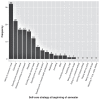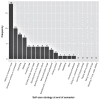Self-care practices and depression, anxiety, and stress scores in veterinary students during a semester
- PMID: 37265816
- PMCID: PMC10204886
Self-care practices and depression, anxiety, and stress scores in veterinary students during a semester
Abstract
Objective: To measure associations between self-care activities and depression, anxiety, and stress of preclinical veterinary students during a semester.
Procedure: Preclinical veterinary students at the University of Calgary Faculty of Veterinary Medicine were recruited voluntarily. Depression, anxiety, and stress scores (DASS-21) were measured, and a self-care questionnaire was administered at the beginning and end of the semester.
Results: Depression, anxiety, and stress scores did not change during the fall semester (P = 1.000). At the beginning of the semester, students who spent 15 to 30 min (P = 0.042) or 30 to 60 min (P = 0.013) outside daily had lower anxiety scores compared to those who spent < 15 min outside daily; students who spent > 2 h daily on social media had higher stress scores than students who spent < 60 min (P = 0.024); and students who slept for 6 to 8 h daily had lower stress scores than students who slept < 6 h (P = 0.015). At the end of the semester, students who "often" felt that self-care techniques managed their stress had lower depression (P = 0.003) and anxiety (P = 0.011) scores than those who "rarely" did; students who spent 30 to 60 min outside daily had lower depression scores than those who spent < 15 min (P = 0.031); students who spent 15 to 30 min (P = 0.002) or 30 to 60 min (P = 0.009) outside daily had lower stress scores than those who spent < 15 min; and students who exercised 30 to 60 min daily had lower stress scores than those who exercised < 15 min (P = 0.047).
Conclusion: Self-care activities that were associated with lower depression, anxiety, or stress scores at the beginning or end of the semester included spending at least 15 min daily outside or exercising; spending < 30 min on social media daily; and sleeping 6 to 8 h daily. These practices warrant further investigation.
Clinical relevance: Encouraging certain self-care practices among preclinical veterinary students has the potential to enhance their mental health and should be considered part of a veterinary school curriculum.
Pratiques d’autosoins et scores de dépression, d’anxiété et de stress chez les étudiants vétérinaires au cours d’un semestre.
Objectif: Mesurer les associations entre les activités d’autosoins et la dépression, l’anxiété et le stress des étudiants vétérinaires au cours d’un semestre.
Procédure: Les étudiants vétérinaires de la faculté de médecine vétérinaire de l’University of Calgary ont été recrutés sur une base volontaire. Des scores de dépression, d’anxiété et de stress (DASS-21) ont été mesurés et un questionnaire d’autosoins a été administré au début et à la fin du semestre.
Résultats: Les scores de dépression, d’anxiété et de stress n’ont pas changé au cours du semestre d’automne (P = 1,000). Au début du semestre, les étudiants qui passaient 15 à 30 min (P = 0,042) ou 30 à 60 min (P = 0,013) à l’extérieur par jour présentaient des scores d’anxiété inférieurs à ceux qui passaient < 15 min à l’extérieur par jour; les étudiants qui passaient > 2 h par jour sur les réseaux sociaux avaient des scores de stress plus élevés que les étudiants qui passaient < 60 min (P = 0,024); et les étudiants qui dormaient de 6 à 8 h par jour avaient des scores de stress inférieurs à ceux qui dormaient < 6 h (P = 0,015). À la fin du semestre, les étudiants qui estimaient « souvent » que les techniques d’autosoins géraient leur stress avaient des scores de dépression (P = 0,003) et d’anxiété (P = 0,011) inférieurs à ceux qui l’étaient « rarement »; les étudiants qui passaient 30 à 60 min à l’extérieur quotidiennement avaient des scores de dépression inférieurs à ceux qui passaient moins de 15 min (P = 0,031); les étudiants qui passaient 15 à 30 min (P = 0,002) ou 30 à 60 min (P = 0,009) à l’extérieur quotidiennement avaient des scores de stress inférieurs à ceux qui passaient < 15 min; et les étudiants qui faisaient de l’exercice de 30 à 60 min par jour avaient des scores de stress inférieurs à ceux qui faisaient de l’exercice < 15 min (P = 0,047).
Conclusion: Les activités d’autosoins associées à des scores de dépression, d’anxiété ou de stress plus faibles au début ou à la fin du semestre comprenaient le fait de passer au moins 15 minutes par jour à l’extérieur ou de faire de l’exercice; passer < 30 minutes sur les réseaux sociaux quotidiennement; et dormir 6 à 8 h par jour. Ces pratiques méritent une enquête plus approfondie.
Pertinence clinique: Encourager certaines pratiques d’autosoins chez les étudiants vétérinaires a le potentiel d’améliorer leur santé mentale et devrait être considéré comme faisant partie du programme d’études d’une école vétérinaire.(Traduit par Dr Serge Messier).
Copyright and/or publishing rights held by the Canadian Veterinary Medical Association.
Figures


References
-
- Perret JL, Best CO, Coe JB, et al. Prevalence of mental health outcomes among Canadian veterinarians. J Am Vet Med Assoc. 2020;256:365–375. - PubMed
-
- Killinger SL, Flanagan S, Castine E, Howard KAS. Stress and depression among veterinary medical students. J Vet Med Educ. 2017;44:3–8. - PubMed
-
- Nahm S, Chun M. Stressors predicting depression, anxiety, and stress in Korean veterinary students. J Vet Med Educ. 2021;48:470–476. - PubMed
-
- Reisbig AM, Danielson JA, Wu TF, et al. A study of depression and anxiety, general health, and academic performance in three cohorts of veterinary medical students across the first three semesters of veterinary school. J Vet Med Educ. 2012;39:341–358. - PubMed
MeSH terms
LinkOut - more resources
Full Text Sources
Medical
